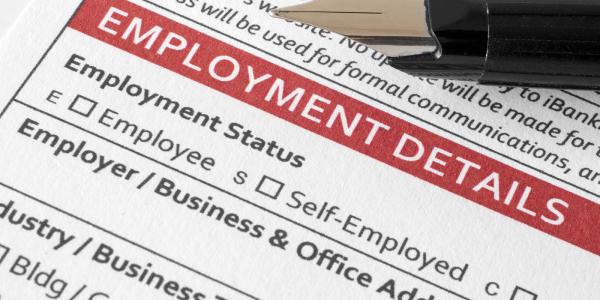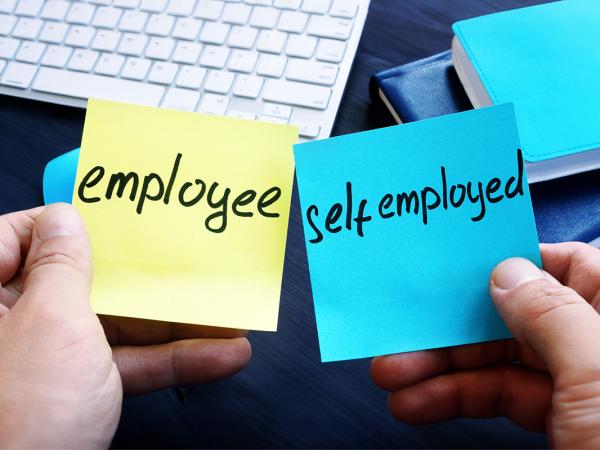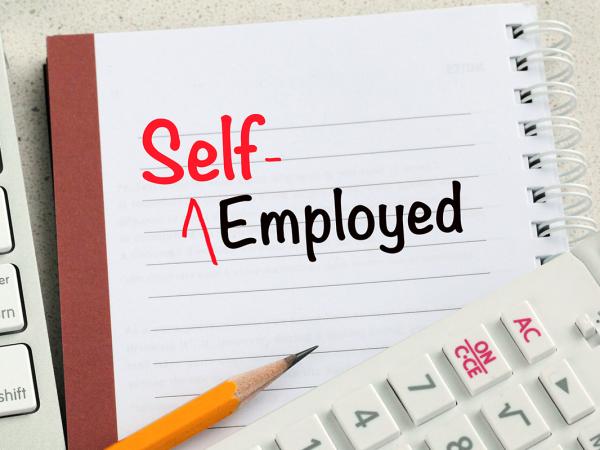Employed, self-employed or neither
This page gives more information on your employment status where you are someone who is, or will be, providing services in your individual capacity. Employment status can be important if you are running a limited company. If you want more information about employment status in the context of this and the IR35/off-payroll rules, see our page contractors using a limited company. We also have separate guidance about partnerships.

Content on this page:
Importance of employment status
Whether you are employed, self-employed, both or neither, will make a difference to the amount of tax and National Insurance contributions (NIC) you have to pay, as well as how you pay.
If you are an employee, your employer is required by law to operate pay as you earn (PAYE) tax and Class 1 NIC on your wages and pay it to HM Revenue & Customs (HMRC) on your behalf. If you are self-employed, you usually pay income tax through the self assessment tax return system, as well as Class 4 NIC, directly to HMRC.
If you think that you are employed, you need to look at our page on employment for more information about your tax position. If you think that you are self-employed, you need to look at our page on self-employment for more information about your tax position.
It is important to know if you are employed or self-employed for employment law purposes too. Those who are employed or self-employed under tax law will usually be employed or self-employed respectively for employment law, but not always.
Finally, it is important to know if you are employed or self-employed because your tax credits or universal credit status may also follow your employment status for tax purposes.
The distinction between employment and self-employment is not always clear. Some businesses try to exploit people looking for work, by treating them as self-employed when they should be treated as an employee. This is known as ‘false self-employment’.
Employment status law
There is no straightforward legal definition of what it means to be employed or self-employed. Over the years the law courts have looked at this question many times, and they have identified some situations in which you are certainly employed and others when you are certainly self-employed. But there are other situations where the position is not clear.
The general rule is that you will be:
- an employee if you work for someone and do not have the risks of running a business.
- self-employed if you have a trade, profession or vocation, are in business on your own account and are responsible for the success or failure of that business.
If it is still not clear, then you need to consider a lot of different factors and then look at the overall picture that emerges (more on this directly below).
When you are likely to be employed
You are likely to be an employee where:
- You can be told what work to do, as well as how, where and when to do it.
- You have to do the work yourself.
- You can be moved from task to task.
- You are contracted to work a set number of hours and get a regular wage or salary, even if there is no work available.
- You have an employment contract and work for a business which is not your own and in which you are not a partner.
- The person or company you work for gives you time off for things like sickness and holidays, which is usually paid subject to the terms of the employment or according to statutory rules.
You can be employed even if you only work part time or have flexible hours or if you are only on a short contract. But if you have a lot of short contracts which you organise and set up yourself, you are more likely to be self-employed.
See also the table at the end of this page.
When you are likely to be self-employed
You are likely to be self-employed if you meet the following tests:
- You agree to do the work, but you can send someone else to do the job for you, for instance, a builder who can send another person with similar skills in their place.
- You probably have several customers at the same time. You can do the work how, where and when you like, for example, a writer who agrees to write a book and can write whenever they want to, as long as they meet the deadline set by the contract.
- You run a business and take responsibility for its success or failure, such as a joiner who has to redo unsatisfactory work and cannot charge the customer for the time spent redoing the work.
- You provide the main items of equipment or specialist tools you need to do your work, such as a pick-up truck, or scaffolding.
None of these tests are conclusive. You must weigh different factors together to get an overall picture – see the table at the end of this page. You will not automatically be self-employed just because you have an existing unique taxpayer reference (UTR) and submit tax returns each year, or your position lacks permanency, or you provide your own small tools.
There is a common misconception that people who work in the construction industry are always self-employed. This is not the case. People who work in the construction industry should work out their employment status in the same way as everyone else.
If you work in the construction industry and you are being dealt with under the construction industry scheme (CIS) then you are being treated as self-employed by your engager. However, it can be difficult to spot this, as under CIS you are given ‘payslips’ (‘payment and deductions’ statements sometimes called a PDS) and are having tax deducted at source.
See also our page on the construction industry scheme.
Unsure if employed or self-employed
If you are still not clear, you should consider the factors set out in the table at the end of this page. In the table, the person for whom you work is called your ‘engager’ – they might be your employer or your client.
You should consider all the questions and then look at the overall pattern which emerges. Does it suggest employment or self-employment? You may also find it helpful to look at our page containing the write up of an important case to see how the courts might apply the tests in the table in a real scenario.
Note that the law here is complex – we have tried to simplify things, but this is not a comprehensive guide. If you are still not clear, you should ask a tax adviser or HMRC for help. We tell you how you can find a professional tax adviser, including through the tax charities, on our page help with tax from friends, family, professionals or other organisations.
Being both employed and self-employed
You can be employed and self-employed at the same time. This would usually be the case if you were doing two jobs. For example, if you work for yourself as a hairdresser during the day but in the evenings you work as a receptionist in a hotel, you will be both self-employed and employed.
In this situation, you would pay tax on your employment income through PAYE and you pay tax on yourself-employment profits via the self assessment system.
You must note that if you have to complete a self assessment tax return because of your self-employment income, you must also include your employment income (and taxes paid) and any other income that you have on your self assessment tax return, not just the self-employment income: it is a ‘return’ of all of your taxable income for the year.
Being neither employed nor self-employed
You can be neither employed nor self-employed but still active.
Examples might be where you are a volunteer, or you are training, or where you undertake an activity on a one-off basis.
Contrary to popular belief, payments which are not employment income will not automatically be classed as ‘self-employment’ income. They will only be self-employment income if your activity is regular, organised, is done with a view to generating a profit etc. (and so is generating trading income under the ‘badges of trade’).
You might be neither employed nor self-employed if you just receive casual amounts for doing something every now and then. For example, if on a one-off basis you made a wedding dress for a friend and she paid you for doing it. Such income could be casual or miscellaneous income. Income from the gig economy is sometimes casual/miscellaneous income and not income from self-employment.
If the total income is no more than £1,000, this may be exempt from tax due to the trading allowance. If it is not wholly exempt under the trading allowance, and there is tax to pay, you will probably need to show the taxable amount as 'any other income' on your tax return. You may be able to benefit from partial relief under the trading allowance rules when working out the taxable amount.
Alternatively, if you have a separate employment, HMRC may be able to collect any tax you owe on casual or miscellaneous income by adjusting your PAYE tax code rather than through a tax return.
There is further guidance on casual/miscellaneous income in HMRC’s Manual.
Employment status for other purposes
You should be aware that the information in this page relates to employment status for tax purposes only. It is possible you may have one status for tax purposes but have a different status for other purposes, such as employment law purposes or tax credits/universal credit.
For example, some individuals working in the gig economy are usually self-employed for tax purposes but have recently been found to be ‘workers’ for employment law purposes by the Courts. For more information about ‘worker’ status, including who it covers and what to do if you think you have ‘worker’ status, please see our dedicated guidance.
Further, while the legal definitions of self-employment in tax credits and universal credit (UC) are based on the concept of a ‘trade, profession or vocation’ from tax law, there are also additional requirements in both benefits – for the person to be recognised as either ‘gainfully’ self-employed in UC or in ‘qualifying remunerative work’ for working tax credit.
This means it is possible to be thought of as self-employed for tax purposes, but not gainfully self-employed for UC purposes (because for example, the activity is not your main employment or is not organised, developed and regular). A similar issue arises with working tax credit. A person is defined as self-employed for tax credits if they are engaged in carrying on a trade, profession or vocation on a commercial basis and with a view to the realisation of profits, either on one’s own account or as a member of a business partnership and the trade, profession or vocation is organised and regular. It is therefore possible for HMRC to find that the person is not self-employed for tax credit purposes but that they are self-employed for tax purposes so that they must file a self assessment tax return.
Summary of key points
This table is a generalised summary of 'indicators' used to judge whether you are employed or self-employed. It is unlikely that you will meet all the indicators for either employment or self-employment. Remember, if you get stuck, HMRC can help you work out your status.
| Employed | Self-employed | |
| Method of payment | Paid a regular wage by the day, week or month | Invoice the client for work done |
| Who has control over how work is done | The way you do your work is supervised | You are trusted to do the work yourself – as long as the final product is up to standard |
| Where you do the work | At the place required by your engager | At a place you decide, although some jobs might have to be carried out 'on site' |
| When you do the work | You are required to turn up at a certain time and work the agreed hours | You have freedom to decide when you do the work, in consultation with your engager |
| Benefits | You are given rewards other than in cash for your work, such as vouchers, free or cheap meals, a company car or shares | You tend only to be paid in monetary form – cash, cheque or bank transfer – rather than 'in kind' although some businesses might engage in 'barter' transactions |
| The work you do | Your engager can move you from job to job as needed – for instance, you may have to cover for someone who is sick | You only do the particular job which you agreed to do, unless you subsequently agree a change in terms of providing your services |
| The number of jobs | You have one job at a time, or a small number of regular jobs, such as one in the morning and one in the evening | You work for a lot of people and you juggle their requests like a builder or a taxi driver |
| Your role | You have a recognised role at the place where you work – for instance, people may report to you, or you may be listed in the internal phone book | You are an independent provider of services and not a permanent part of the engager's business |
| Your business | You do not run a business from home or other location, although you may work from home if this is approved or demanded by your employer. When you need another position, you apply for jobs for example by contacting the Jobcentre or an employment agency, or answering advertisements online or in the newspaper | You have a business which you may run from home – for instance, you advertise your services, you take appointments, you have your own business cards, you are VAT registered |
| Who does the work | You do the work yourself | You may send someone else to do the work for you, or arrange for a job to be done and supervise others who you engage to help you. For example, if you are a gardening business, you might take on a job landscaping a 2 acre garden. You would be unlikely to do it all yourself, but you would quote a price for the job and in turn pay other people to help you. |



